As COVID-19 hits Peru, a brave Berkeley Ph.D. student finds her way home
Borders close, but along the Nanay River, doors unexpectedly open
April 3, 2020
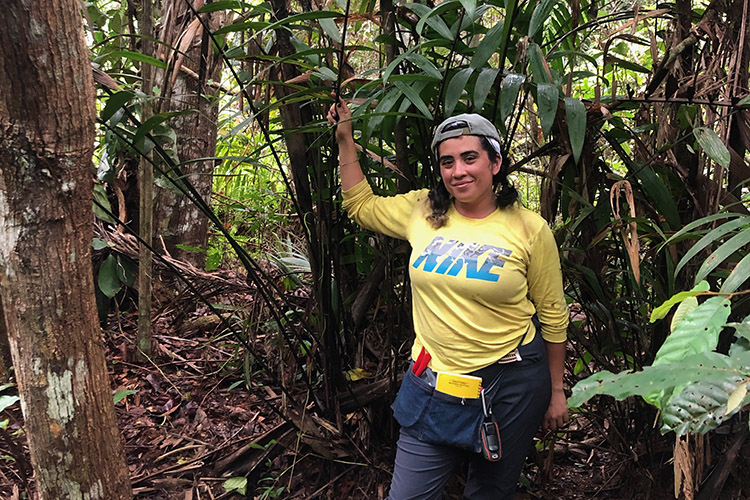
In Pucaurco, her furthest palm tree specimen collection site along Peru’s Nanay River, Berkeley Ph.D. student Giovanna Figueroa was excited to find a multi-stemmed Oenocarpus species, “O. minor, I suspect,” she said. (Photo by Paul Anderson Shapiama Murayari)
Even the most remote river community on the Peruvian Amazon’s Nanay River got the news. On TVs and radios that work just two hours a day, with electricity supplied by generators that run at night, the 20 to 30 families living in Pucaurco learned on March 16 of the government’s 15-day quarantine for all of Peru, to stem the spread of COVID-19. Ground and river travel were suspended; a nighttime curfew would follow.
Giovanna Figueroa, a UC Berkeley Ph.D. student in the Department of Integrative Biology, had just arrived in the village the previous day, after a 16-hour boat trip from her base in Iquitos, the rainforest’s largest city and one that can’t be reached by roads. When the local guide she’d hired told her the latest, Figueroa was pressing herbarium specimens, preserving palm fruit pulp samples and pleased with her first day of research in Pucaurco on a two-week trip along the Nanay, a 196-mile tributary of the Amazon River.
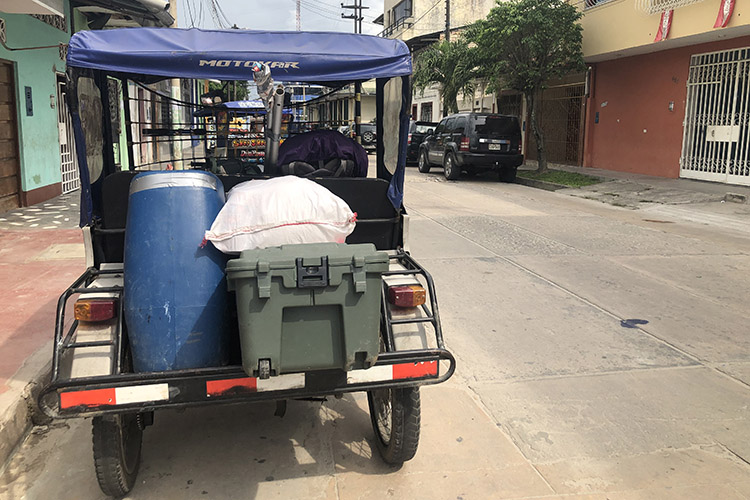
On March 13, this mototaxi, one of the main ways people get around in Iquitos, Peru, was packed and ready to take Berkeley researcher Giovanna Figueroa to the Nanay River, a tributary of the Amazon River, where she would travel 16 hours by boat to her first research site — the remote community of Pucaurco. (Photo by Paul Anderson Shapiama Murayari)
At first, Figueroa said, “I was really skeptical and doubtful. I’d heard of the coronavirus when I left the U.S. on February 25, but things hadn’t blown up yet. I also wondered, ‘How do you shut down a river, especially to small, personal boats?’” No roads lead to the area. In the third year of her doctoral program, and on a time-sensitive fellowship, she resolved to stay and finish her carefully-scheduled field work in three villages.
Figueroa, who’d also worked in Peru the previous year, felt at home pitching a tent, climbing palm trees — she studies human-plant interactions in tropical environments — and living off the beaten path, without a car or cell phone service. Relying on her native Spanish allows her to easily communicate and connect with locals. She didn’t fear for her health, as Peru had few COVID-19 cases at the time.
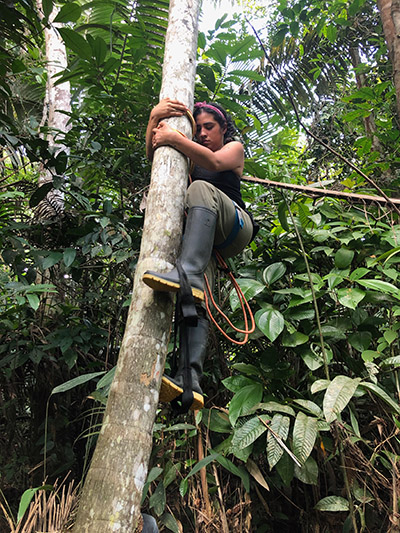
In the Western Amazon, Giovanna Figueroa climbs Oenocarpus bataua, a palm tree that produces ungurahui, a protein-rich fruit that can be eaten and pressed for its nutritive oil. (Photo by Alejandra Amacifuen)
But later, when the Peruvian government extended the South American country’s state of emergency and began to shut down all international travel, Figueroa, who’d completed 10% or less of her research goals and had the flexibility to stay in Peru until August, resignedly changed her mind.
“I decided I needed to find a way out,” she said. “I was worried about my family. If my folks in Southern California got sick, I might not be able to get home. And I only had enough cash for a month in the field; there are no banks or ATMs there. If I couldn’t leave, I’d have to wait for someone to get me and bring me money, and I’d have a large debt to repay.”
But to catch a plane in the distant port city of Iquitos — if a humanitarian organization or U.S. Embassy flight could even be arranged — would first mean a risky river journey. Its success would rely on Figueroa’s smarts, a lot of luck and help from colleagues, near and far.
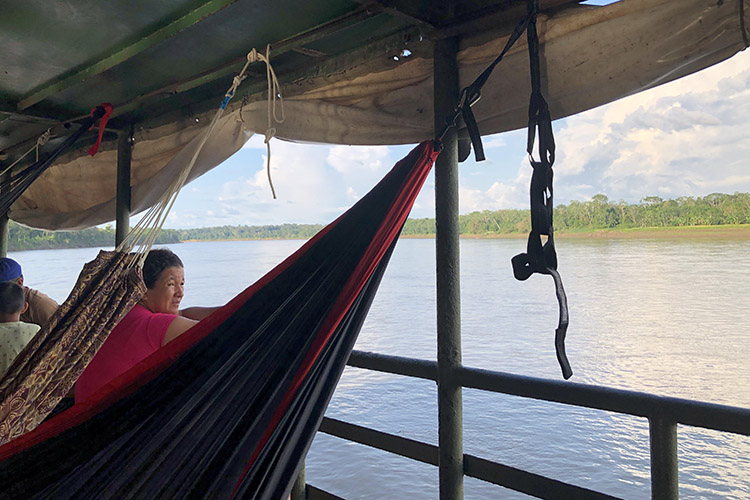
When she arrived in Iquitos, Peru, UC Berkeley’s Giovanna Figueroa took a “lancha,” like this one, as she began her trip on the Nanay River. Shown here on the Ucayali River, the main headwater tributary of the Amazon River, a lancha “is a bit slower, but more comfortable than cramped smaller and faster boats,” she said. “People can hang up their hammocks and rest … and larger cargo can be transported on the bottom level.” (Photo by Giovanna Figueroa)
Berkeley roots in the rainforest
Since 1999, Paul Fine, a professor of integrative biology at Berkeley, has traveled to the Peruvian Amazon to study tropical tree diversity. The Western Amazonian rainforests, near Iquitos, have the world’s highest number of tropical trees species — at least 8,000 of the 16,000 estimated to live in the Amazon basin— along with unusual geological formations, a variety of rainforest ecosystems and the world’s most diverse insect herbivore communities.
Figueroa, one of three Ph.D. students currently in The Fine Lab at Berkeley, is studying economically important palm trees native to the Amazon rainforest, including Oenocarpus batua, which produces ungurahui, an olive-sized fruit that’s purple when ripe. Delicious and protein-rich as food, the fruit also is pressed for its nutritive oil. Fine and his colleagues are working on ways to sustainably harvest it to provide income and jobs for this remote tropical zone’s residents and to stop the felling of palm trees.

Giovanna Figueroa is used to pitching a tent on her research expeditions to Peru. She took this photo of her encampment at a beach site along Peru’s Rio Blanco in September 2019, while doing research on economically important palm trees. (Photo by Giovanna Figueroa)
On a Berkeley Mentored Research Award, “Gio had a full year’s stipend that allowed her to be based in Peru and use all her funding for research expenses, without having to teach” as a graduate student instructor, something she’d done for four semesters, said Fine.
When Fine’s advisees are in the field, “I don’t micromanage what they’re doing,” he said. “We talk about their goals, and when I feel confident they have a good plan, I trust them.” But he stays in touch regularly and connects them with his Peruvian colleagues and friends, many he said he’s known for 20 years and “who I consider family members.”
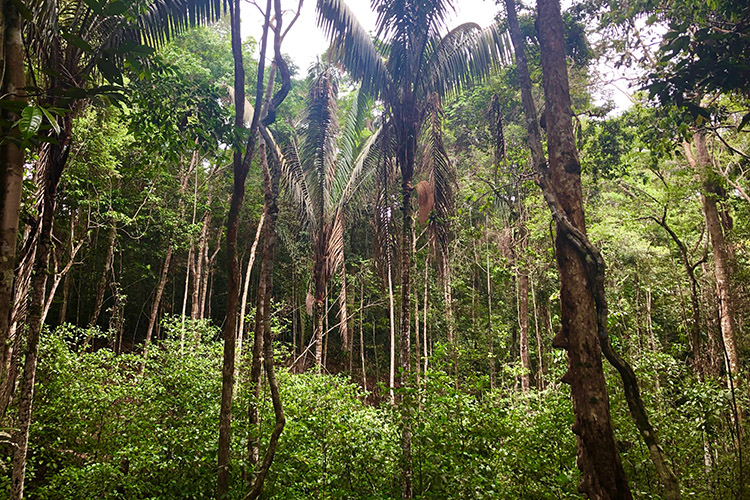
This stand of Oenocarpus bataua is in the Reserva Nacional Allpahuayo-Mishana in the Western Amazon. (Photo by Giovanna Figueroa)
One is Paul Anderson Shapiama “Shapi” Murayari, Figueroa’s field assistant on this trip. He works at Recursos Amazónicos Frutales, a company Fine supports in Iquitos that sells pulp from Amazon tree fruit — aguaje, camu camu and ungurahui — and makes palm tree climbing gear, so that harvesting fruit is easier and safer.
After Peru’s COVID-19 crackdown intensified, said Fine, “Gio texted me immediately, and I was trying to stay abreast of the situation and giving her updates. … I tried to tell her to be prepared, … that it might be impossible for her to get out for a long time. I knew that if she did have to be quarantined, she was in a safe place,” he said.
But Figueroa “said she had a plan to leave for Iquitos,” said Fine, and although she had no permit to get through checkpoints along the Nanay, he described her as “pretty much her own actor — she’s got a good head on her shoulders.”
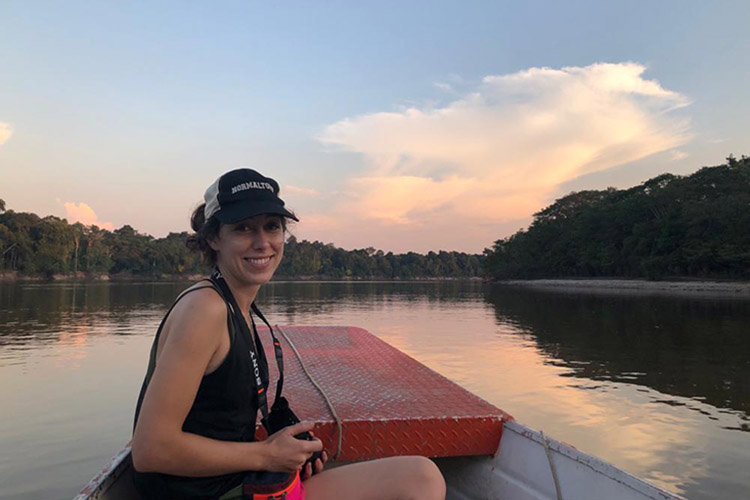
Julie Tierney, a Ph.D. candidate in ecology and evolutionary biology at Princeton University, also does field work in the Amazon basin. She said she and Giovanna Figueroa have become great friends who are “no strangers to problem-solving difficult situations in the field, and when we are together, we are able to laugh through our problems.” (Photo by Giovanna Figueroa)
Figueroa also had colleague and friend Julie Tierney, a Princeton University Ph.D. candidate, in Iquitos, pledging to help her get there, and to get them both back home. They’d met in Peru in 2018 and, said Tierney, “as women doing remote work in a foreign country, we support each other both logistically and personally.”
The logistics would have a glitch: The women’s GPS devices — in the field, Figueroa carries one for emergencies — were unable to sync. And Figueroa’s field assistant’s phone had run out of data and could only receive calls, and that’s if a cell phone signal was available on the riverway.
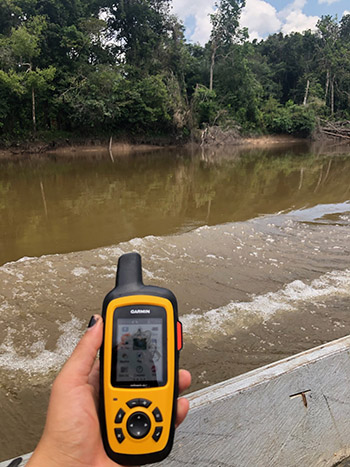
Giovanna Figueroa carried this InReach satellite GPS device, loaned to her, along with a first aid kit, by the UC Berkeley Field Safety office, for emergencies while she was in Peru. In this photo, she is on a boat ride from Diamante Azul, a community on the Nanay River, to a larger village, Santa Maria, where she managed to get through the river checkpoint without a permit. (Photo by Giovanna Figueroa)
An uncertain journey to Iquitos
Early on, despite the news, Figueroa harbored hope of finishing her work. She left Pucaurco by boat on March 18 with Peruvian government health workers — they’d arrived there the day before to do malaria tests — who were headed to Santa Maria, a town of about 2,000 people and the first of two checkpoints on the way back to Iquitos. They would do malaria tests at stops along the way, and Figueroa eventually would split off from them to get to her next field site in San Juan de Raya.
But she never made it there.
At Diamante Azul, a small village about two hours from Santa Maria, Figueroa and the Ministry of Health workers, tired and hungry, chose to spend the night. The next day, instead of leaving at noon, as planned, the workers got delayed, and “the military police showed up to enforce the quarantine order,” said Figueroa. She made the tough decision to “wait (the order) out in Diamante, rather than mess with getting past the police,” she said. “I didn’t have any special pass.”
For the next several days, she examined palm trees with Murayari, Diamante Azul Mayor César Ruiz and his son, Silfo, and she bathed on river beaches and enjoyed fish dinners with local families who welcomed her.
Then, on March 22, Figueroa learned that Peru’s borders were closed indefinitely, and that the country wouldn’t support foreigners wanting to return home. “It’s an hour fresh out of the president’s mouth. I’ll be in touch,” Tierney confirmed for Figueroa. (They could talk only if Figueroa sent her a GPS message to call Murayari, if his cell phone worked; there was spotty service in Diamante Azul).

Fried fish and yuca — a dinner that Giovanna Figueroa enjoyed at a house-diner in Diamante Azul, a community on the Nanay River in Peru. (Photo by Giovanna Figueroa)
Tierney gave Figueroa’s contact information to the U.S. Embassy in Peru, to get her on an evacuation flight manifest. She also contacted officials at Princeton, while Fine made similar calls at Berkeley, including to Gina Daly, director of federal relations, who so far this semester has handled the cases of four students trapped abroad during the COVID-19 crisis.
Meanwhile, Figueroa asked Diamante Azul’s mayor for a pass to get her through the military-patrolled checkpoints to Iquitos; he said he’d help if there was a flight being arranged. A U.S. Embassy-organized flight from Iquitos to Miami, scheduled for March 26 at noon, looked promising.
But the mayor, while offering Figueroa a boat ride from his son on March 25, suddenly refused her a permit. “He said I’d have to present my case to the military police” at the checkpoints, said Figueroa, who chose to brave it and accept the ride.
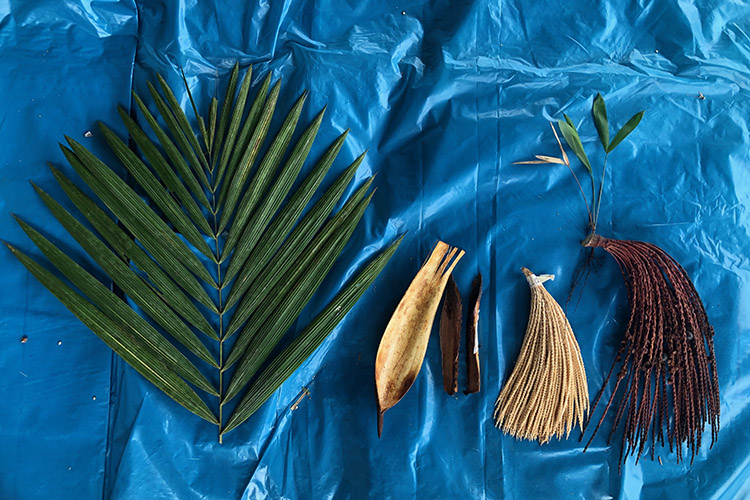
This collection was made by Berkeley researcher Giovanna Figueroa from a multi-stemmed Oenocarpus species in the Peruvian Amazon. (Photo by Giovanna Figueroa)
In Santa Maria, however, the military police stopped Figueroa, unwilling to let her and Murayari continue on the Nanay River unless she could show her name on a flight manifest. Without a cell phone to display that information, she had no proof. But when Murayari began talking with the authorities, “it made the police more amicable,” she said. “They just let us go with no pass, no proof.”
They parted with the mayor’s son at 3 p.m. in Anguilla, where another boat driver was to complete the trip. But the man insisted on leaving the next day at 3 a.m., to escape travel in the hot midday sun and to skirt just the last two hours of a new national 8 p.m. to 5 a.m. curfew set by Peruvian President Martín Vizcarra. Figueroa knew then that she’d miss her noon flight.
“I told Julie, ‘You’ve done all you can for me. You should get on the flight. I’m just far away, and that’s what it is,” she said. “I’m a student stuck in Peru, and the right people are now aware of my situation.”

In Iquitos, Peru, at the Coronel FAP Francisco Secada Vignetta International Airport, health workers screen passengers waiting to check in for their March 26 evacuation flight during the COVID-19 pandemic. (Photo by Giovanna Figueroa)
“I’d held it together until that point,” said Figueroa. “An old man gave me some really nice grapefruit-infused water that he’d made. I took a bath in the river. There was an empty building where they let us pitch our tents. I’d taken a Benadryl, as my anxiety wouldn’t let me sleep.”
Anxiety and miracles
But while she was brushing her teeth, Figueroa said the boat driver’s brother approached her and urged, “‘Let’s go now. I’ll leave you at the first port in Iquitos.’ It was 8 p.m. I said, ‘I don’t have a permit (for the checkpoint in Yarana); but we’ll see what happens.”
Tierney, hearing of the plan, said “this was the most scared for Giovanna’s safety that I’d been this entire time. The toque de queda (curfew) forbid anyone from leaving their houses for any reason. … the police had already made over 16,000 arrests throughout the country. Because she couldn’t receive this news, I feared she didn’t know how dangerous it would be for her to travel during these hours.”
In the boat, Figueroa hung up her hammock and fell into a deep sleep. Miraculously, “I don’t think we stopped (at the checkpoint),” she said. “We got to Iquitos at 5:30 a.m.” She repaid the boat driver by racing to a gas station to fill her portable plastic gas container with fuel for him, then she and Murayari caught a mototaxi to fetch the rest of her belongings.
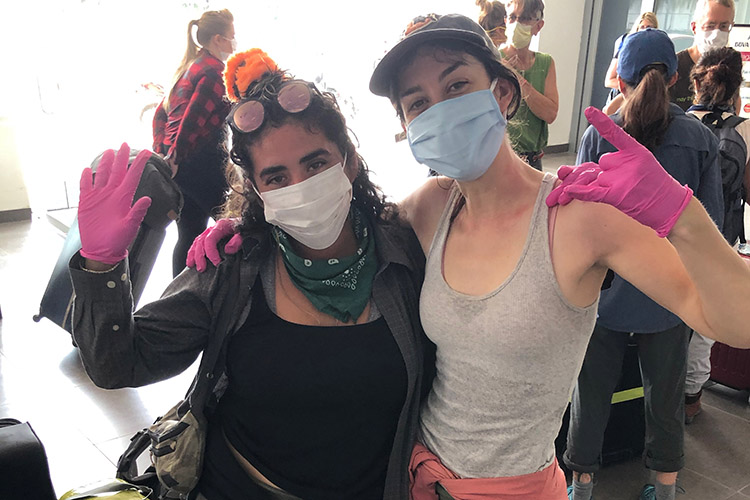
Reunited at the airport in Iquitos, Peru, after a dangerous river trip by Berkeley Ph.D. student Giovanna Figueroa (left), Figueroa and her friend and colleague Julie Tierney, a Princeton University Ph.D. student, briefly break social distancing rules during the COVID-19 crisis. (Photo courtesy of Giovanna Figueroa)
“We got stopped once by the police because the driver wasn’t wearing (coronavirus) face protection. I had an extra bandana and gave it to him,” she said. “So, we took roads I’d never been on before to the apartment/office where my things were stored.”
It was 7 a.m. on March 26, and Figueroa, leaving her field assistant at the apartment, made it to the plaza by 8:30 a.m., when her airport shuttle arrived. “At the airport, I finally was reunited with Julie. We hugged, no social distancing,” she said. “I’d barely made it.”

A flight out of Iquitos, Peru, organized by the U.S. Embassy, flies somewhere over Cuba on its way to Miami. (Photo by Giovanna Figueroa)
Passengers were given health screenings in the terminal, and on board “there was celebration,” said Figueroa, despite everyone wearing face masks and sitting a seat apart. Within five hours, she was in Miami, where Princeton had booked a hotel suite for Figueroa, Tierney and a Ph.D. student from Cornell University who’d also been in Peru.
Figueroa rented a car the next day and drove four hours to her cousin Sonya’s place in St. Petersburg, to rest before heading to Southern California. “The first thing I did was laundry; it was all damp and smelly,” she said. “My cousin fed me really, really good food. I slept well and took naps. I’ve been watching the news; I’ve been so disconnected.”
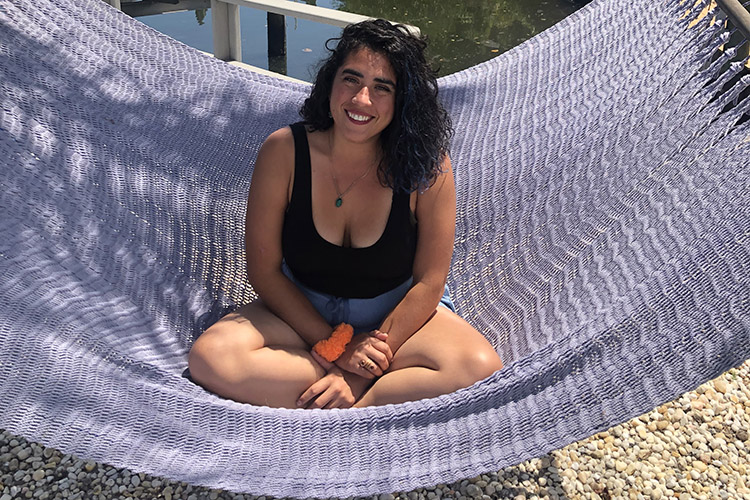
In St. Petersburg, Florida, where her cousin Sonya lives, Giovanna Figueroa rested up from her Peruvian research adventure during the COVID-19 crisis before heading home to Southern California. (Photo by Sonya Figueroa-Martinez Wegner)
It’s hard for her to reflect just yet on the past few weeks. “I’ve had zero time to process,” she said. “I’ve been running on adrenalin.”
But Figueroa said she wouldn’t be back in the states “without the support system from Paul’s network, the role the university played, the Princeton connection and the relationships I’ve made through my work.”
Today, she is finally home in California, where Fine said he has good news: He’s received a grant and can hire Figueroa to return to Peru in the fall and continue her research.